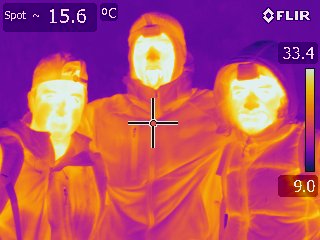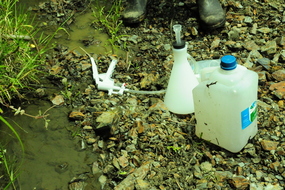Cheers!
~Alex
|
In between swabbing frogs, writing grants, eating and trying to catch my breath from walking up the stairs, I took another walk along the orchid trail. Apparently I missed a few the first time around! I'm going to skip trying to identify them this time, but if you're interested in any let me know as I have some of the names written down.
Cheers! ~Alex
0 Comments
For a trip that is all about finding frogs, our posts have been lacking in our results. In fact, we've found about 175 frogs so far! Some, like the Hyalinobatrachium bergeri above, are incredibly abundant. We found this male glass frog guarding two egg clutches last night while the creek while other males called around him, vying for a mate. We found these Gastrotheca excubitor while we were searching the puna. Like it's lower elevation relative G. nebulanastes, this marsupial frog has no tadpoles. Instead the eggs develop directly into small frogs within a pouch on the mother's back. In the high elevations of the puna we found these frogs hiding under rocks during the day to conserve moisture. This female Bryophryne cophites is another species well suited to the high elevations. The eggs of this frog undergo direct development after being laid in the moss. These Psychrophrynella usurpator are some of the most common frogs around Wayqecha. During the day they can be heard singing from the grass and ferns surrounding the comedor. Like the previous two species, this frog lacks a tadpole stage and undergoes direct development. These direct developing frogs are perfectly adapted to this high elevation environment where standing water can be scarce.
Cheers! ~Alex Yesterday morning was spent huffing and puffing as we flipped rocks at 3500m in the high shrublands, cloud forest and puna (high grassland). Despite the light-headedness, this is truly a spectacular meeting of three different habitats. The stunted trees of the cloud forests drip with moss while the puna is dominated by grasses and Ericaceae. Among the puna's grass and rock there are orchids, begonias and other "tropical" species mixed with the alpine species like lupine. In total we found 4 species of frog and 1 species of lizard (more on them at a later time). Standing water in the puna is scarce so the amphibians that survive there do so without having an aquatic, tadpole, phase (like the Gastrotheca mentioned in an earlier post). During the day the frogs and lizards here can be found under rocks to conserve moisture. The transition into cloud forest is rapid, often as we turn the corner into a creek bed the forest begins. Here the plants are more diverse, although still adapted to the cold, high environment. One of these creeks is even home to a diatom named after Wayqecha.
On our way out we collected more water for eDNA filtering as well, in hopes of finding traces of some of the high elevation species lost to Bd. ~Alex A lab contribution published today in the Proceedings of the National Academies of Sciences USA investigates patterns in the occurrence and magnitude of published mass mortality events. These rare demographic events coincide with the rapid and catastrophic demise of individuals. Like other rare events, the increase in scientific publishing might bias our perception of the frequency of mass mortality events. Although the occurrence of mass mortality events generally follows the increase in the number of scientific publications, this factor only explains part of the variation in the occurrence of events. Moreover, the magnitude (number of killed individuals) of mass mortality events has increased among birds, fish and marine invertebrates. Among amphibians and reptiles, the magnitude of mass die-offs has decreased, but the occurrence of events has increased sharply over the past decades.
Reblogged from Alex's website. Seriously, go there! NOW! I've been a little busy writing grants the last few days, but today I took a quick walk along the orchid path here at Wayqecha. Below are only a few of the about 200 species of orchid found here. I've tried to identify some, but I am by no means a botanist so my id's may be very wrong. Cheers!
 Here's a short post to introduce the team. The idea was to take a selfie but the thermographic camera does not allow such picture...hence I (Alessandro) am missing from the image, but some of you will certainly recognize, from left to right: Alex Shepack (he keeps trying to divert traffic from this lab blog to his website), Mike Britton who's a doctoral student with Mo Donnelly at Florida International University, and Alex Ttito from the Universidad San Antonio Abad in Cusco. As you can see this enthusiastic team is able to stay warm when frog hunting at 3000 m despite incessant rain and temperatures around 10-12 C. We use the thermographic camera to measure body temperatures of frogs along the Andean slopes and down to the Amazonian lowlands -- see below the image of a Pristimantis pharangobates calling from a branch. This photo was taken yesterday night at a place where a long line of trucks, buses and cars that were stuck behind a landslide were spending the night (and are presumably spending much of today as well). The landslide has interrupted traffic along the road connecting Cusco to the Amazon lowlands, so we will only be able to visit highland sites above the landslide in the next few days. Just a short video while I work on making a whole day series. This is just about 1.5 hours of clouds moving over the mountains of Wayqecha. Cheers! ~Alex
The generator has shut off for the night and the internet is dragging so there will be no cross posting today. Instead, make sure you head over to my blog to check out some more photos and posts from our trip!
In addition to surveys and call recordings, this year we are also filtering stream water to screen for the presence of species that have gone missing since the mid 2000's following the outbreak of chytridiomycosis in the region. There are at least 19 species that have not been seen in over 10 years, especially in the cloud forest at mid-elevations (in the Andes that means around 1500-2000 m). Among them the harlequin toad Atelopus erythropus and the glassfrog Nymphargus truebae illustrated below. The majority of missing species are stream-breeding amphibians.  The idea is to extract DNA from the filtered water and amplify gene sequences to detect and quantify the presence of DNA from target species through real time PCR. This technique will complement our visual and auditory surveys -- which so far have failed to confirm the presence of our target species in recent years. This week we have been collecting water samples from several creeks and filtering these samples either at the collecting site or in the lab. Of course what seems a very straightforward thing to do can generate its own complications in the field. In addition to the rain that can fall at any time during the day and turn bucolic streamlets into raging (and turbid --quickly clogging the filter) torrents, our fantastic pumping equipment (a manual vacuum pump) failed spectacularly after the fourth or fifth stream. Without a pump it is impossible to filter the water, and after a short period of despair for the loss of our manual pump, Alex who by now knows quite a bit about Shigella (see previous post) proposed to use the old gas pump from the rugged car (I carry several replacement parts in the car). The new setup works better and faster that the manual pump, although we are still working on getting a reliable and durable source of power for the pump (taking the battery of out the car every time would just be annoying) -- we are using flash batteries for now. We hope to find some of those missing species -- stay tuned for preliminary results once we analyze the samples.
|
Archives
March 2024
CATENAZZI LABNews from the lab Categories |